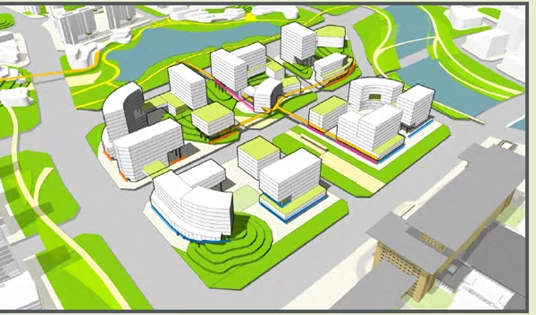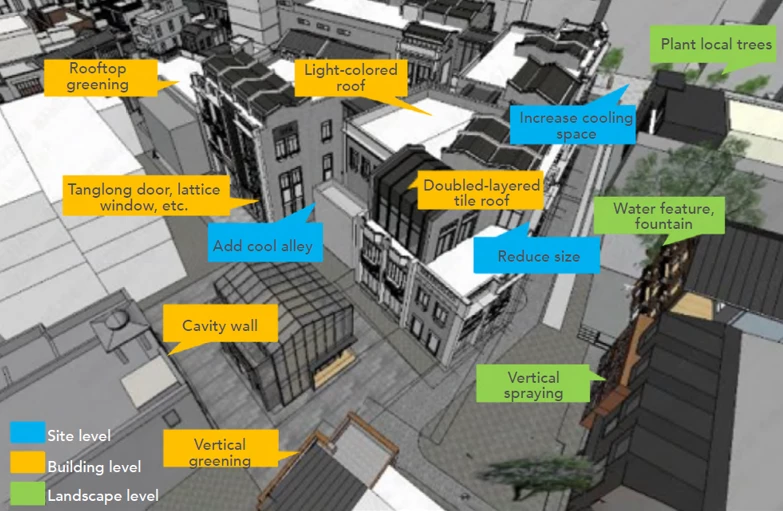How can we address climate change and extreme heat in a sustainable way?
Climate change has brought cities unprecedented challenges manifested in higher temperatures, heat waves, floods, and storms. In addition, the energy and transport sectors in cities contribute substantially to greenhouse gas emissions. Cities therefore have an important role to play in reducing global greenhouse gas and carbon dioxide emissions. Implementing green and cost-effective solutions to keep cities cool and reduce their residents’ dependence on air conditioning, is one important action. By working in harmony with nature, cities worldwide can find simple yet effective cooling solutions.
Guangzhou, one of the largest and fast-growing cities in China with a population of roughly 19 million people, is facing the challenges of coping with heat waves that are exacerbated by heat island effects – a phenomenon caused by lack of vegetation, dark/grey surfaces, poor urban design and intensity of industrial activities.
Likewise, urban areas all around the world are struggling to keep themselves cool as temperatures continue to rise. The summer of 2023 has seen intense heatwaves around the world with numerous places repeatedly breaking high-temperature records and July being the hottest month on record.
Development of modern technology, particularly the invention of air conditioning, has provided a way for the residents of cities to cope with high temperatures. However, while indoor spaces are getting cooler, air conditioning consumes a tremendous amount of energy, exacerbating the urban heat island effect and contributing to greenhouse gas emissions.
We need greener and more comprehensive solutions to address urban heat
To cope with increasing temperatures in a sustainable way, cities can use nature-based cooling solutions. Nature-based solutions for cooling reduce air temperature through well-articulated green and water spaces, channeling wind flows, greening building facades and roofs. Besides bringing relief from heat in a greener and more sustainable way, nature-based cooling solutions are also good investments. Research shows that utilizing green spaces, water bodies, reflective roofs, and pavements can deliver 12 times their cost in net benefits and cool cities by 0.5˚C, with 3-5˚C – in indoor air temperature reduction.
Nature-based solutions developed by the city of Guangzhou
The city of Guangzhou presents an example of how cities can use nature-based solutions for cooling to alleviate rising temperatures. Guangzhou strives to reach carbon neutrality before 2060 and has adopted comprehensive measures towards low-carbon development including a cooling city action plan.
In partnership with the World Bank, Guangzhou has piloted innovative urban cooling solutions in the historic neighborhood of Yongqing Fang, the green ecological district of the China-Singapore Knowledge City, and the Haizhu Wetlands located in the city center.

The Guangzhou experience shows that by working in harmony with nature, cities can benefit from their environment. The pilot projects used nature-based solutions combined with traditional approaches to mitigating urban heat and improving the living environment. These solutions include:
Leveraging wind flow to establish a “natural air conditioning system” in the city. Wind is crucial for cooling a city, and cool breezes can lower temperatures and dissipate heat, reducing the urban heat island effect. However, modern high-rise buildings often block the natural wind flow. Guangzhou has identified and restored these cooling sources while preserving six major ventilation corridors along mountains, water systems, and open spaces.

Making use of natural cooling sources. Forests, lakes, and rivers serve as a natural cooling source. Guangzhou city planners did a stock-taking of the city’s existing natural assets and planned its cooling interventions around them. In addition, the city is using vertical greening on buildings as a simple, low-cost, and effective insulation, which reduces facade temperature and filters out glare and dust.
Restoring ancient local architectural climate wisdom. Through centuries of development and practice, Guangzhou has developed many unique traditional wisdoms, including the comb-like layout and cooling alleys to promote natural ventilation and cooling. In the historic Yongqing Fang neighborhood, traditional building elements such as hollow walls, double-layered tiled roofs that insulate against heat, and flexible doors and windows that promote ventilation have been restored and reused, giving a new life to ancient climate adaptation wisdom.
Creating “breathing” urban fabric to cool neighborhoods. The Yongqing Fang Phase II project has adopted urban design measures that are expected to include widening some streets, decreasing the size of buildings, using light color coatings and rooftop greening, planting local trees, and increasing water features.

Knowledge developed by Guangzhou in partnership with the World Bank, can be scaled up and replicated in other cities in China, as well as urban areas around the world. The results of the pilot activities offer important lessons for establishing a framework for cooling solutions for urban planners, developers and municipal decision-makers. Applying such a framework can help cities identify and employ their existing natural assets, such as water bodies and parks, as well as historical climate adaptation wisdom, accumulated throughout the history, as cost-effective yet impactful solutions.

Traditional cooling measures in Guangdong, China. Source: Guangzhou Urban Planning & Design Survey Research Institute
Learn more about the Piloting Nature-Based Urban Solutions for Cooling in the city of Guangzhou. For the reports, see:
Overview: Piloting Nature-based Solutions for Urban Cooling
Guidelines on Integrating Nature-based Passive Cooling Options into Urban Planning and Design
Assessment of Key Ecosystem Services Provided by the Haizhu National Wetland Park in Guangzhou, China




Join the Conversation